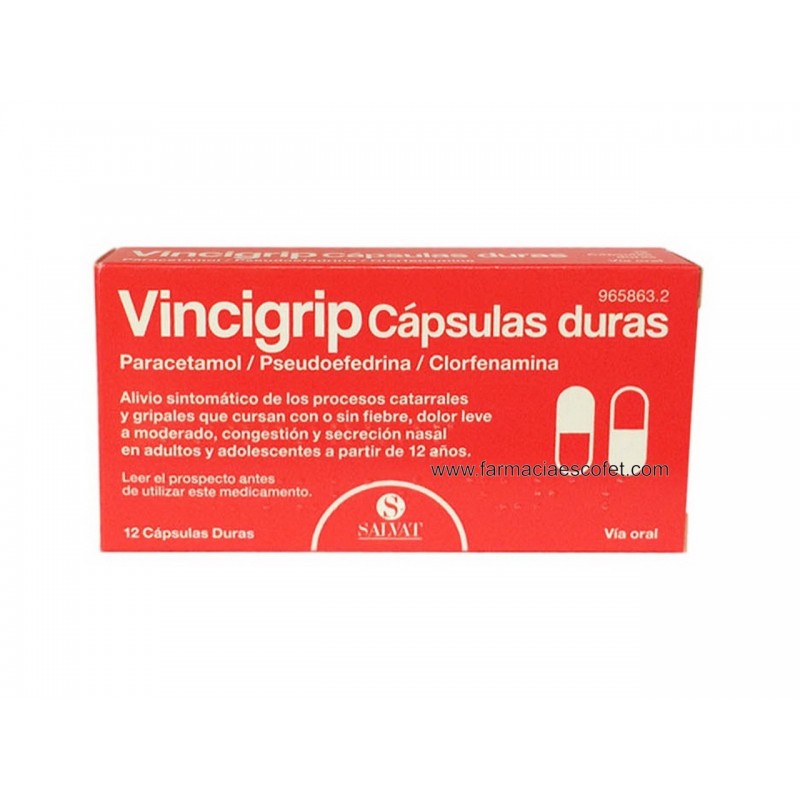



Symptomatic relief of influenza and catarrhal processes that occur with mild to moderate pain, fever and nasal congestion.
What Vincigrip is and what it is used for
It is an association of paracetamol, pseudoephedrine and chlorphenamine.
Acetaminophen is a pain reliever that reduces pain and fever.
Chlorphenamine is an antihistamine that relieves a runny nose.
Pseudoephedrine is a sympathomimetic that reduces nasal congestion.
It is indicated for the symptomatic relief of colds and flu that occur with or without fever, mild to moderate pain, congestion and runny nose in adults and adolescents from -12 years.
You should see a doctor if it worsens or does not improve or if the fever persists for more than 3 days or the pain or other symptoms persist for more than 5 days.
How to take Vincigrip
Always take this medicine exactly as described in this leaflet or as your doctor or pharmacist has told you. If in doubt, ask your doctor or pharmacist.
The recommended dose is:
Adults and adolescents from 12 years of age: 1 capsule (500 mg of paracetamol) every 6 or 8 hours (3 or 4 times a day).
Do not take more than 3 grams of paracetamol every 24 hours.
Patients with liver, kidney or heart disease: they should consult their doctor.
How to drink:
Vincigrip is taken orally.
Take the capsule with a glass of water or another non-alcoholic drink.
If the medication is taken at night, it should be taken a few hours before bedtime to reduce the possibility of insomnia in patients with difficulty sleeping.
Taking the medicine is subject to the appearance of symptoms. As these disappear, this medication should be discontinued.
Use in children and adolescents
This medication is contraindicated in children and adolescents under 12 years of age.
Use in patients over 65 years
These patients cannot take this medication without consulting their doctor.
They are usually more prone to the adverse effects of pseudoephedrine and chlorphenamine.
If you take more Vincigrip than you should
If you have ingested an overdose, you should go to a medical center quickly even if there are no symptoms, as these often do not manifest until 3 days after ingestion of the overdose, even in cases of severe poisoning.
Overdose symptoms may be: dizziness, vomiting, loss of appetite, yellowing of the skin and eyes (jaundice), and abdominal pain. Anxiety, fear, agitation, headache (may be a symptom of high blood pressure), seizures, insomnia (or severe drowsiness), clumsiness, fainting, instability, confusion, irritability, tremors, anorexia; psychosis with hallucinations (the latter especially in children). Dry mouth, nose, or throat. Effects such as high blood pressure, arrhythmias (fast or irregular heartbeat), palpitations, reduced urine output. Metabolic acidosis (decrease in the alkaline reserve of the blood). In prolonged use, plasma volume depletion may occur (decrease in blood volume).
In more serious cases it can occur: decreased potassium in the blood (hypokalemia), mental disorder with altered reality perception (psychosis), seizures, coma and hypertensive crisis.
Treatment of overdose is most effective if started within 4 hours of taking the drug overdose.
Patients on barbiturates or chronic alcoholics may be more susceptible to the toxicity of a paracetamol overdose.
In case of overdose or accidental ingestion, immediately go to the doctor or the Emergency Department of the nearest hospital or consult the Toxicological Information Service (telephone: 91 562 04 20), indicating the medicine and the amount ingested.